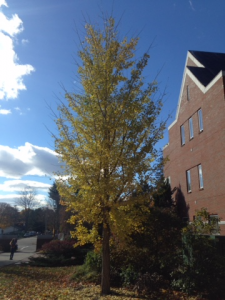Ginkgo
Ginkgo biloba | Family: Ginkgoaceae
Submission: Rebecca Leloudis ’18
Leaves – simple, deciduous, and fan-shaped with or without 1 or more sinuses; produced on short spur shoots; veins are approximately parallel.
Twigs – Light reddish brown, becoming gray with numerous and obvious spur shoots; buds are broadly conical to dome-shaped and reddish brown.
Buds – rusty brown, broadly conical to dome-shaped, with multiple scales.
Cone – 1″ in diameter, yellow-orange with a fleshy outer layer and a strong, unpleasant odor; matures in autumn, only on female trees.
Bark – pale grey, irregularly ridged, becoming more deeply furrowed and ridged with age.
Natural History:
Ginkgo biloba, commonly known simply as ginkgo or the maidenhair tree, is a deciduous gymnosperm native to China. It is commonly planted as an ornamental species throughout the Eastern United States. In its native stands the ginkgo grows on rich sandy soils, but is a fairly hardy species capable of living in a wide range of soil types. The female ginkgo trees are somewhat infamous for their seeds, which produce a strong and unpleasant scent when crushed. Despite the fleshy appearance these naked seeds are not a fruit, as G. biloba is a gymnosperm, not an angiosperm.
Ginkgo is the only extant member of the family Ginkgoaceae, and is strikingly similar in appearance to fossils of related trees, which date back as far as 270 million years. It is unclear if any truly wild Ginkgo trees still exist; the tree has been cultivated in China and Japan for millennia, and many of the ‘wild’ Ginkgo stands in China are thought to have been grown and maintained by monks centuries ago. Today it is a common ornamental, and is used in a variety of dishes in Chinese cuisine, including congee. Ginkgo is often marketed as a supplement intended to improve memory, attention, and baseline cognitive function. It has also been studied as a potential treatment for Alzheimer’s and dementia. However, there is little to no evidence that Ginkgo is an effective supplement for improving cognitive function, and NIH studies into its efficacy as an Alzheimer’s/dementia treatment declared that ginkgo was “ineffective at slowing cognitive decline.”
References:
Elias, T.S. 1980. The Complete Trees of North America Field Guide and Natural History. Van Nostrand Reinhold Co., N.Y. 948pp.
Harlow, W.M., Harrar, E.S., Hardin, J.W. and White, F.M. 1991. Textbook of Dendrology. McGraw-Hill Inc., N.Y. 501pp.
Petrides, G.A. 1972, A Field Guide to Trees and Shrubs. 2nd edition. Houghton Mifflin Co., Boston. 428pp.
Preston, R.J., Jr. 1989. North American Trees. 4th edition. Iowa State Univ. Press. Ames. 407pp.
Shane, J. 2004. Dendrology Handbook, University of Vermont, Unpublished.
